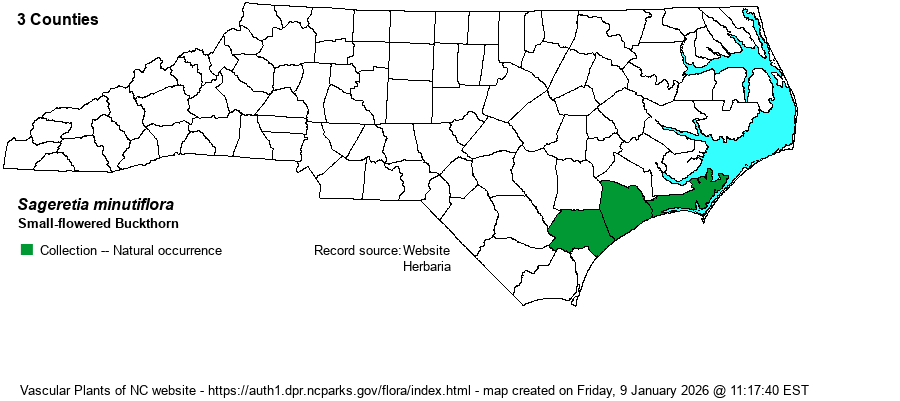| Author | (Michaux) Mohr | |
| Distribution | Strictly along the southern coast, ranging northward only to Carteret County. It is known from only Carteret, Onslow, and Pender counties; surprisingly there are no records as yet from Brunswick or New Hanover counties.
This is mainly a coastal species, occurring from southeastern NC to southern MS; but it does occur inland in much of FL.
| |
| Abundance | Very rare along the NC coast, with only a handful of sites known. It is a State Threatened species. | |
| Habitat | This species has very strict, and thus rare, habitat requirements. In the state it is found only over shell deposits or other marl/coquina substrates that occur along the edges of maritime forests or in maritime thickets, typically very close to a salt marsh edge. |
| Phenology | Blooms in September; fruits in late fall, probably mainly in November. | |
| Identification | This is a “strange” woody plant that is vine-like but is actually a leaning shrub with many short, thorn-like branches. It grows to about 9-10 feet long; typically there are several such stems present so that the plants can form a tangle over other shrubs or saplings. The leaves are deciduous and opposite, but they are thick and glossy dark green, giving a somewhat evergreen look. They are quite small, being ovate in shape with wavy margins and grow only to 1-1.5 inches long. The species has a long terminal cluster of very small white flowers followed by small black “berries” (drupes) that can remain into the winter. However, in NC the species is not often seen blooming or fruiting. It can be confused with Yaupon Holly (Ilex vomitoria) if one looks only at the leaves, as both have quite small, dark green, and thick leaves; but the holly is a widely branching shrub with alternate leaves, whereas Sageretia is a narrow shrub that appears in the field to be a leaning vine. Some people might confuse Sageretia with some type of privet (Ligustrum spp.), as these non-native plants have opposite leaves. However, privet species tend to have much longer branches that are not somewhat thorn-like. | |
| Taxonomic Comments | None
| |
| Other Common Name(s) | Smallflower Mock-Buckthorn | |
| State Rank | S1 | |
| Global Rank | G3G4 | |
| State Status | T | |
| US Status | | |
| USACE-agcp | FAC link |
| USACE-emp | | |

